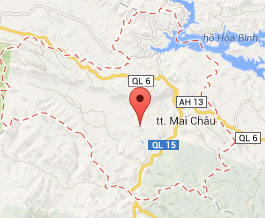Mai Chau Ecolodge The window to Mai Chau
Traditional Stilt Houses in Vietnam
Posted date: 11/8/2019 7:32:10 PM
The humble Vietnamese stilt house is the postcard image of rural Vietnam. Everything is centred here: family, livestock, tools and handicrafts, each carrying a strong symbol of rural Vietnamese life in the valleys, rivers and mountains. Its residents are usually those of Vietnam’s minority ethnic groups, who have lived a millennia-old and beautifully tranquil existence in some of Vietnam’s most stunning surrounds. Many stilt houses in Vietnam can be found in Mai Chau, where Mai Chau Ecolodge provides some of Vietnam’s best eco-accommodation styled on the traditional housing of the Thai ethnic group.
.jpg)
- Flood Prevention – The number 1 aim of the stilt house is to mitigate the regular floods that sweep through Vietnam. These usually happen in lowland areas like the Mekong Delta but can also occur in the highlands such as Ha Giang province. Houses resting on their 4-metre-high stilts are spared the agony of flooding and the chaos it can create.
- Predator Evasion – One of the lesser known benefits of a Vietnamese stilt house is to avoid killer predators that historically made their ways into villages. Snakes and tigers were once commonplace in the Vietnamese countryside and posed a serious threat to the security of villagers. The stilt houses of Vietnam’s ethnic Thai once occupied lands where wild elephants roamed, meaning that their stilts had to reach sky-scraping heights in order to offer proper protection.
- Natural Air-Con – It is a relief, come summer, to own a tall stilt house in rural Vietnam. Air has space to circulate below the floor and cool its residents within, as well as come through wide windows that often feature across most of the wall space.
- A Room with a View – Stilt houses are often built over a landscape that the owner would like to keep an eye on. Usually, this is the workplace – either the fields of rice paddies under their watch or the lake and river where they catch their meals.
- Keeping Livestock Close – The space under a house is perfect for livestock, which can roam free in total shade. This negates the necessity for expensive stables or paddocks, but the smell that can arise from this can be quite a scent.
.jpg)

|
Who? |
Where? |
Style |
|
The H’mong |
Northern mountain regions such as Sapa, Son La, Yen Bai and Ha Giang. |
Low stilts or even no stilts, due to the normal lack of flooding in mountainous areas. Simple wooden slats for walls with roofs made of palm leaves or ceramic tiles. |
|
The Thai |
Northern valley regions such as Mai Chau, Nghe An, Lai Chau, Son La and Yen Bai. |
High stilts to avoid the flooding of valleys and to provide views over the stretching rice fields. Thick wood used throughout and an open area within where the family eat, sleep and socialise. |
|
The Xo Dang |
Central provinces such as Kon Tum, Quang Nam and Quang Ngai. |
The Xo Dang community house is one of the most iconic stilt houses of Vietnam. It has thick tree trunks for stilts, a low body, but an incredibly tall thatched roof for air circulation. Access to the house is via ladder rather than stairs. |
|
The Ede |
Central highland provinces such as Dak Lak, Gia Lai, Phu Yen and Khanh Hoa. |
The Ede live in longhouses up to a staggering 100 metres in length. They are very low to the ground but still require a ladder to enter. The Ede are a matriarchal society and demonstrate that through their architecture, which is flecked with many motifs of fertility and womanhood. |
|
The Cham |
Southern provinces such as Ninh Thuan and An Giang |
The Cham live in stately stilt houses which can rise as little as a foot off the ground. This is Vietnam’s Muslim ethnic group, so wooden partition walls and curtains are used to accept male and female guests in different areas of the house. |

Where to see Traditional Stilt Houses in Vietnam?
Those looking for the best places to see traditional Vietnamese stilt housing can find them across the length of the country. While they are usually dotted around villages in off-the-beaten track destinations, there are a few hotspots of housing located in or very near to Hanoi.
The Museum of Ethnology, Hanoi
Not only does this fabulous museum in Vietnam’s capital contain comprehensive information about its different ethnic groups, but it also has some full-scale replicas of wooden Vietnamese housing at the back. Visitors can see the housing of the Cham, Ede, Thai, Xo Dang, Nung and many others in the museum’s garden, all fully equipped and explorable within.
Thai Hai Ethnic Village, Thai Nguyen
For visitors to Vietnam with no time to travel to its underrated northeastern regions, Thai Hai ethnic village in Thai Nguyen has you covered. This village is about 80km from Hanoi and covers 70 hectares of gorgeous gardens, quaint paths and traditional Vietnamese architecture at its finest. The village is a recreational space created to showcase ethnic Tay and Nung customs, comprising 30 houses moved from an at-risk area in the mountains.

Mai Chau Ecolodge, Mai Chau
Nestled in a green valley about 3 hours southwest of Hanoi, Mai Chau Ecolodge offers up 43 ethnic Thai stilt houses taking the form of luxury and eco-conscious accommodation in Vietnam. Each building has been built with materials from the nature beyond its doorstep: the fabulous valley region of Mai Chau, where the greenery of the forested mountains is matched by that of the fields of rice. Like the Thai houses of our neighbouring villages, the rooms of Mai Chau Ecolodge are made of wood, bamboo, stone and palm leaf, and are placed high, overlooking the spectacular scenery on offer.
Inside each room, guests can find 4-star facilities and truly unique amenities. The private, outdoor shower in the back courtyard keeps guests close to nature, while a large double bed, open veranda, plunge pool and freestanding bathtub made of jackfruit tree wood keeps them in luxury. Motifs of the Thai ethnic group are found across the wall décor and the gorgeous embroidered bedspread, which joins the outside architecture as the perfect experience of Vietnamese stilt house accommodation.
If you would like to find out more about what Mai Chau Ecolodge can offer you through our award-winning traditional Vietnamese housing, please click here. Thanks for reading!
Share This











